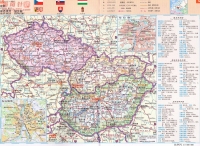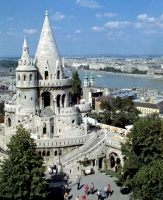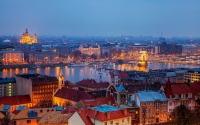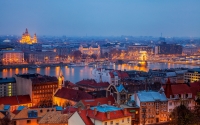|
英国 United Kingdom 爱尔兰 Ireland 比利时 Belgium 荷兰 Netherlands 法国 France 西班牙 Spain 葡萄牙 Portugal 意大利 Italy 希腊 Greece 奥地利 Austria 匈牙利 Hungary 德国 Germany 瑞士 Switzerland 罗马尼亚 Romania 俄罗斯 Russia 波兰 Poland 克罗地亚 Croatia (Hrvatska) 捷克 Czech 芬兰 Finland 瑞典 Sweden 挪威 Norway 冰岛 Iceland 土耳其 Turkey 丹麦 Denmark 阿尔巴尼亚 Albania 爱沙尼亚 Republic of Estonia 安道尔 Andorra 白俄罗斯 Belarus 保加利亚 The Republic of Bulgaria 波斯尼亚和黑塞哥维那 Bosnia and Herzegovina 梵蒂冈 Vatican City State (Holy See) 黑山 The Republic of Montenegro 拉脱维亚 Latvia 立陶宛 Republic of Lithuania 列支敦士登 Liechtenstein 卢森堡 Luxembourg 马耳他 Republic of Malta 马其顿 The Republic of Macedonia 摩尔多瓦 The Republic of Moldova 摩纳哥 Monaco 塞尔维亚 the Republic of Serbia 斯洛伐克 The Slovak Republic 斯洛文尼亚 the Republic of Slovenia 圣马力诺 San Marino 乌克兰 Ukraine | ||||
Hungary
Capital:budapest Country Code: hu
| ||||
|
国名 匈牙利共和国(the Republic of Hungary)。
国名释义 以民族名称命名。一般认为匈牙利的主要民族马扎尔族即匈牙利族。“匈牙利”的含意是“十个部落”。 国旗 呈长方形,长与宽之比为3∶2。自上而下由红、白、绿三个平行相等的横长方形相连而成。红色象征爱国者的热血,还象征国家的独立和主权;白色象征和平,代表人民追求自由和光明的美好愿望;绿色象征着匈牙利的繁荣昌盛,象征人民对未来充满信心和希望。 国徽 为盾徽。盾面垂直分为两部分:左边为平行、红白相间的宽条;右边下方是绿色的山峰,峰顶上有一顶王冠,王冠上面是白色双十字图案,这是主教标志。盾徽上面是一个圣斯提芬大王冠,王冠之上有一倾斜的十字架,传说十字架是王冠被窃时让小偷压斜的。 国歌 《匈牙利共和国国歌》。 独立日 11月16日(1918年) 国庆日 8月20日(1949年) 大屠杀纪念日:4月16日(1944年) 争取自由斗争日:3月15日(1848年) 民族 马扎尔族占总人口的98%,其他有日耳曼族、斯洛伐克族、罗马尼亚族、塞尔维亚族等。有一说法是中国古代的匈奴。 (有诗证明:我们那遥远的祖先,你们是怎么从亚洲走过漫长的道路,来到多瑙河边建立起国家的?---------匈牙利诗人 裴多菲) 首都 布达佩斯(Budapest)。人口170万(2006年1月1日)。 主要城市 米什科尔茨、德布勒森、塞格德。 货币 福林。 同北京时差 -7.00 国际电话码 36 国花 郁金香——(百合科) 名胜 巴拉顿湖、巴拉德拉洞群、圣·伊斯特万大教堂。 风俗 妇女婚后,便用花布把头发包住,这是与未婚少女的最大区别。结婚需经求婚、订婚和迎娶三个阶段,订婚的仪式必不可少,双方都由一位女性亲戚陪同去神父处登记。 国家政要: 总统绍约姆·拉斯洛 (Solyom Laszlo) ,2005年6月当选;总理久尔恰尼·费伦茨(Gyurcsany Ferenc) ,2004年9月当选,2006年4月,社会党在国会大选中获胜,赢得组阁权,同年6月,久尔恰尼宣誓就任总理。 人口 1006万(2007年1月1日)。主要民族为马扎尔族(即匈牙利族),约占98%。少数民族有斯洛伐克、罗马尼亚、克罗地亚、塞尔维亚、斯洛文尼亚、德意志和吉卜赛等族。官方语言为匈牙利语。居民主要信奉天主教(66.2%)和基督教(17.9%)。15岁以上公民有98.9%的人具有基本教育水平。 自然地理 面积为93030平方公里。是位于欧洲中部的内陆国家,全境以平原为主,80%的国土海拔不足200米,属多瑙河中游平原。多瑙河以东的匈牙利大平原,面积约5万平方公里,还有西北部的小平原,大部海拔100-150米。山地不足五分之一,北部为喀尔巴阡山脉的一部分,海拔300-1,000米。北部山地的凯凯什峰为全国最高点,海拔1015米。西部外多瑙山地为阿尔卑斯山的余脉,一般海拔300-500米,最高科里什峰,海拔704米。包科尼山南麓的巴拉顿湖,为中欧最大湖泊。 山区森林茂密,有栎树、山毛榉、椴树等;平原有大片草原,发育有肥沃的黑土。重要河流为多瑙河及其支流蒂萨河。巴拉顿湖为最大淡水湖。属温带大陆性气候,平均气温1月-4~-2℃,7月20~22℃,年降水量480~800毫米,自西向东递减。东邻罗马尼亚,南接塞尔维亚,西与奥地利接壤,北与捷克、斯洛伐克、乌克兰为邻。铝土矿储量丰富,分布在外多瑙山地一带;还有煤、石油、天然气、铁、锰、铀等矿藏。全境三分之二地区有地下热水蕴藏。 简史 匈牙利国家的形成起源于东方游牧民族──马扎尔游牧部落,公元9世纪时他们从乌拉尔山西麓和伏尔加河湾一带向西迁徙,公元896年在多瑙河盆地定居下来。公元1000年,圣·伊斯特万国王加冕,正式建立封建国家。15世纪下半叶马嘉什国王统治时期是匈牙利历史上较为辉煌的时期。1526年土耳其入侵,封建国家解体。1699年开始全境由哈布斯堡王朝统治。1848年爆发了科苏特领导的自由革命斗争。1849年4月匈国会通过独立宣言,建立匈牙利共和国,但不久被奥地利和沙俄军队所扼杀。1867年奥匈协定宣布成立奥匈帝国。第一次世界大战后奥匈帝国解体。1918年11月匈宣布成立第二个资产阶级共和国。1919年3月21日匈牙利苏维埃共和国成立,同年8月被帝国主义干涉者联合武装进攻所颠覆,恢复了君主立宪政体,开始了霍尔蒂的法西斯统治。1945年4月苏联红军在匈牙利人民配合下解放了匈全境,1946年2月宣布废除帝制成立匈牙利共和国,1949年8月20日成立匈牙利人民共和国并颁布宪法。1956年10月爆发匈牙利事件。1989年10月23日,根据宪法修正案,决定将匈牙利人民共和国改称匈牙利共和国。1999年底通过王冠法,并成立以总统为首的王冠委员会。 政治 1989年匈牙利政局发生急剧变化,同年2月,匈牙利社会主义工人党(简称社工党)宣布放弃执政党地位,实行多党制。此后,匈党内矛盾不断公开化,最后导致党的分裂。1989年10月,社工党改名为社会党,提出要在匈牙利建立“民主社会主义”。当月,匈国会通过宪法修正案,把“匈牙利人民共和国”改为“匈牙利共和国”,决定取消作为集体国家元首的共和国主席团,实行总统制;确立多党制和议会民主的法治国家;取消马列主义政党在国家机构中的领导作用的规定。 经济 匈牙利是一个具有中等发展水平的国家,工业基础较好。匈根据本国国情,研发和生产一些有自己特长的和知识密集型产品,如计算机、通讯器材、仪器、化工和医药等。匈采取各种措施优化投资环境,是中东欧地区人均吸引外资最多的国家之一。 自然资源比较贫乏,主要矿产资源是铝矾土,其蕴藏量居欧洲第三位。此外有少量褐煤、石油、天然气、铀、铁、锰等。森林覆盖率约为18%。农业基础较好,在国民经济中占重要地位,不仅为国内市场提供丰富的食品,而且为国家挣取大量外汇。主要农产品有小麦、玉米、甜菜、马铃薯等。旅游业比较发达。 匈牙利虽然资源贫乏,但山河秀美,建筑壮丽和富有特色,这里温泉遍布,气候四季分明,各国游客慕名而来。主要旅游点有布达佩斯、巴拉顿湖、多瑙河湾、马特劳山。坐落在多瑙河畔的首都布达佩斯是欧洲著名的古城,风光无限,有“多瑙河上的明珠”之美誉。欧洲最大的淡水湖巴拉顿湖也是吸引大批游客的一个亮点。另外,匈牙利的葡萄美酒也为这个国家增光添彩,以其历史悠久、酒味醇香闻名于世。匈牙利独特的自然风光和人文景观使其成为旅游大国,成为匈外汇重要来源之一。 1989年以来,匈牙利经历了从计划经济向市场经济的转变,其目标是尽快地与欧洲经济溶为一体。随着政治局势的稳定和经济的不断发展,匈牙利于1996年加入了经济合作发展组织,1999年加入北大西洋公约组织,2002年欧盟宣布将于2004年接纳匈牙利、波兰、捷克等申请加入的国家为其正式成员。匈现正按照欧盟的法律框架加紧完善其国内法律体系。 九十年代中期,匈大刀阔斧地推行了一套经济改革计划,即在市场经济的基础上实施私有化和经济自由化的政策,大力吸引外国投资。改革取得了明显的成效,匈失业率逐年下降,通货膨胀大幅度降低,外国投资不断涌入,匈很快地走上了以出口带动经济快速增长的道路,近2000家国营企业在私有化过程中被出售,私营经济占国内生产总值的比例由1989年的20%增至2000年的80%以上。 1997—2000年,匈经济平均增长率超过了4%。2001年,尽管其国内生产总值的增幅放慢,但仍然是中东欧地区增长率最高的国家之一,且高于欧盟的平均增长水平。 在过去较长一段时期,匈牙利通货膨胀率一直高居不下,严重制约着经济增长。为此,匈中央银行采取了严格的货币政策,确保物价的稳定,控制通货膨胀的攀升。2001年,匈中央银行放弃了执行多年的汇率小幅贬值机制,将其上下波动幅度各增加15%,并将原来实行的福林与美元挂钩改为与欧元挂钩。通过各方面的努力,2002年匈通货膨胀率由上年的6.8%降到了5.3%,经济增长率为3.3%,经济增长主要得益于旅游和建筑业的持续增长以及政府采取的增加工资、扩大消费需求的财政刺激政策。2002年,经常账户赤字计划保持在国内生产总值的4.5%以下。匈货币福林目前已实现了自由兑换。 2002年穆迪投资服务公司将匈牙利政府外币债券的信用评级由BBB3提高到A1。匈在中东欧地区竞争力的排名仅次于斯洛文尼亚居第二位。 【工业】 匈牙利工业政策是以促进投资为宗旨,以支持企业的研发和创新以及建立起一个广泛的产品供销网络为目标,提高工业竞争力以便为加入欧盟做好准备。匈工业主要行业有机械制造、医药、信息技术和食品加工等。 匈2000年工业生产增长率为18.3%,而2001年降至4.1%,2002年更降至2.6%.匈工业生产增长主要来自于信息技术、电讯和家电等部门的发展。 【基础设施】 匈牙利的交通基础设施在政府的支持下进行了大规模重建,高速公路公里数不断增加。铁路仍属国营,由于其运输成本低且安全可靠而被广泛地运用于工业运输。匈牙利国际机场位于布达佩斯市郊,该机场拥有两个现代化的航空集散站。 匈牙利电信系统较为完善,其移动通讯业尤为发达。为了符合加入欧盟的要求,匈牙利政府2001年通过了一个电信自由化法案。该法案开放了国内和国际固定电话市场,移动通讯市场亦已放开。目前,匈牙利国家电话公司在国际长途和国内固话市场上仍占主导地位。匈牙利目前约有50家互联网服务供应商。 【劳动力】 匈牙利劳动力素质较高,其劳动力人口约为410万,大都受过高等教育且具有特定的技能和专长。匈牙利受教育人口比例超过了人口总数的98%,大约三分之二的劳动力已经完成了一种专长或多种形式的技术培训和职业教育,匈牙利许多年轻人掌握英语、德语和法语等外语。 2001年匈牙利失业率为5.4%,大大低于欧盟的平均水平。匈牙利各地区就业状况存在较大差别,西北地区技术工人短缺,特别是金融和市场营销人才,而多瑙河的东部失业率则高于全国的平均水平。 匈牙利的工资水平大大低于西欧地区,与中东欧的平均水平相差无几。匈东部地区的劳动力成本比西部低,但劳动者的技术水平与西部不相上下。 【匈牙利的外国投资】 外国投资是匈牙利外贸出口和经济增长的重要动力。通过私有化进程,匈吸引了大批的外国投资。 在私有化方式上,匈牙利并未采用大部分东欧国家所实行的票券私有化方式,因为票券私有化大大地限制了外国投资者收购匈整个公司的可能性。匈牙利鼓励外国投资者整体收购国有企业。 自1990年以来,匈共有1500多家国有企业实现了私有化,私有化收入超过100亿美元。自1995年6月《私有化法案》及其修正案颁布以来,私有化进程明显加快,其程序也更加透明。匈牙利私有化和国有控股公司是负责管理和出售国有企业资产的专门机构。 自1990年以来,外国投资者在匈投资创办了约30000家企业,投资额约为284亿美元,约占中东欧地区吸引外资的三分之一,匈牙利因而成为中东欧地区吸收外资最多的国家之一。匈人均吸引外资2480美元,位居中东欧地区首位。 在匈牙利投资较多的国家还包括法国、意大利、日本和英国等国。投资额在1000万美元以上的项目中,美国占29%,德国占26%,法国占11%,荷兰占10%。 外资产值约占国内生产总值的三分之一,雇用了全国43%的劳动力,其出口额占全部出口的70%。 外资企业对提高匈牙利的劳动生产率起到了重要的作用。这些企业大多重视产品质量和技术创新,并开始建立起新的产业,如汽车组装、零部件生产、电子工业元件等。外资企业对于匈牙利电信、医药和食品工业的现代化更是起到了关键作用。 外国投资的产业结构正发生变化:制造业的比例从2001年的50%下降至2002年的36%,而在房地产、租赁、辅助商业活动(16%)、金融服务业(12%)、电力和天然气、供暖和供水(9%)等领域投资比例都有显著的提高. 目前世界上最大的50家跨国公司中已有45家进驻匈牙利,其中包括:通用电器、通用汽车、奥迪、IBM,Elextronics、菲力普、诺基亚、Ameritech-Deutsche Telekom,Electrolux、西门子公司等。一些跨国公司将其在匈实现的利润又进行了再投资。 越来越多的外资企业将注意力集中在高附加值、高品质的产品中。很多公司如通用电器、通用汽车、欧宝、诺基亚、奥迪、西门子、 Flextronics、菲力普、爱立信等企业已经迁往匈牙利。通用电器照明公司决定于2002年2月将位于伦敦的负责欧洲、中东和非洲地区事务的区域性中心迁至匈牙利。 由于匈牙利的地理位置优越,越来越多的外资企业倾向于在匈牙利建立辅助性服务中心,通用电器公司、Dlageo Pic和电子数据系统公司在过去的两年中已经在匈牙利建立了辅助中心。 在过去的几年中,匈政府重点鼓励发展以下行业:住房、桥梁和高速公路建设、中小企业的发展、旅游、创新和研发(特别是在信息科技领域)。 【匈牙利的外贸】 匈牙利是世界贸易组织(WTO)的成员,并将在2004年成为欧盟的一员。它同时还是欧洲自由贸易协定(EFTA)、中欧自由贸易地区(CEFTA)的成员。另外,匈还与以色列、土耳其、克罗地亚和爱沙尼亚签定了双边自由贸易协定。为符合世界贸易组织的规定,自2001年1月1日起,匈牙利取消了来自于世界贸易组织成员国的产品配额。从欧盟和中欧自由贸易额地区国家进口的工业产品的关税也同时取消。 匈牙利对外贸易分类 匈牙利的出口增长主要依赖于在匈投资的跨国公司,其出口额中的70%来自于这些企业。 90年代中期,随着外国投资的大量涌入,匈牙利出口增幅较快,1997年和1998两年的增长率均达到20%,2002年贸易增长率为12.6%,外贸总额达343亿美元,其中进口增长了11.7%,达376亿美元。 与过去相比,匈牙利主要贸易伙伴已发生了很大变化:对欧盟的外贸额占其外贸总额的三分之二,而在1989年前,与前经互会国家的贸易占其外贸的三分之二。2002年匈牙利82%的产品出口到发达国家,其中75.1%销往欧盟国家,而14%销往欧盟国家,而14%销往中欧自由贸易协定国家。在进口方面,匈牙利从发达国家的进口占进口总额的66.8 %,其中56.3%来自于欧盟,16-17%来自于其它地区。 2002年,匈牙利主要贸易伙伴:德国、奥地利、意大利、法国、美国,对匈出口较多的国家分别为德国、意大利、奥地利、俄罗斯、中国、法国、日本和美国。 匈牙利外贸的产业结构发生了很大变化:出口产品中机械产品所占的比例由1991年21%增至2002年的58%:制成品居于第二位,占30.8%。燃料和电力维持在原水平(2-3%)。农产品、食品以及原材料在出口中所占的比例在过去几年持续下降,约占9%。2002年,农产品和食品所占比例接近7%,在进口方面,机械设备的进口占比最高,为52%,其次是制成品,占35.5%。 匈牙利进口的主要产品有:石油、天然气、汽车零部件、计算机设备、汽轮机、测量仪器;出口的产品有:电子产品、机械设备、交通工具(非铁路)以及化工产品等。 新闻出版 目前在匈办报无须批准,到文教部登记即可。不少刊物有外国股份。2001年发行量较大的全国性报纸有7种,其它刊物87种。主要日报有《地铁报》、《今日一瞥》、《人民自由报》、《民族体育报》、《匈牙利民族报》、《快报》、《匈牙利新闻报》、《人民之声报》。匈牙利通讯社为国营,1880年成立。主要广播电台有科舒特广播电台(1949年成立)和裴多菲广播电台,均为国营电台。此外还有鲍尔多克广播电台和道努比乌斯广播电台。主要电视台有匈牙利电视台,国营,1958年成立。多瑙河电视台,私营。 外交 奉行独立的、以民族利益为基础的对外政策。在维护东西方平衡的外交关系的同时,争取返回欧洲,早日加入欧盟。1999年3月,匈牙利正式加入北约。2004年5月1日,匈牙利正式成为欧盟成员国。 与中国关系 1949年10月6日,匈牙利与中国建立大使级外交关系。 Names In the late middle age, the Latin terms "Natio Hungarica" and "Hungarus" referred to all noblemen of the Kingdom. A Hungarus-consciousness (loyalty and patriotism above ethnic origins) existed among all inhabitants of this state. However, according to István Werbőczy's Tripartitum, the "Natio Hungarica" were only the privileged noblemen, subjects of the Holy Crown of Hungary regardless of ethnicity. The Latin name Regnum Hungariae/Vngarie (Regnum meaning kingdom); Regnum Marianum (The Kingdom or Reign of St. Mary); or simply Hungaria was the form used in official documents from the beginning of the kingdom to the 1840s, the German name (Königreich Ungarn) from 1849 to the 1860s and the Hungarian name (Magyar Királyság) in the 1840s and from the 1860's to 1918. The names in other languages of the kingdom were: (Hungarian: Magyar Királyság, Polish: Królestwo Węgier, Romanian: Regatul Ungariei, Serbo-Croatian: Краљевина Угарска/Kraljevina Ugarska, Slovene: Kraljevina Ogrska, Czech: Uherské království, Slovak: Uhorské kráľovstvo. History of the Kingdom of Hungary Medieval Hungary controlled more territory than medieval France (with only the Holy Roman Empire being larger than Hungary), and the population was the third largest of any country in Europe. The Kingdom of Hungary arose in present-day western Hungary and present-day western Slovakia, and subsequently spread to remaining present-day Hungary, to Transylvania (in present-day Romania), present-day eastern Slovakia, Carpatho-Ruthenia, Vojvodina (in present-day Serbia) and other smaller nearby territories. It existed in personal union with the Kingdom of Croatia from 1102 until 1918 under the name Lands of the Crown of St. Stephen. The Hungarian Holy Crown of Saint Stephen.The first kings of the Kingdom were from the Árpád dynasty. In the early 14th century, this dynasty was replaced by the Angevins, and later the Jagiellonians as well as several non-dynastic rulers, notably Sigismund, Holy Roman Emperor and Matthias Corvinus. At the Battle of Mohács in 1526, the Hungarian army was defeated by the forces of the Ottoman Empire, and Louis II of Hungary ran away and drowned in the Csele Creek. Under the Ottoman attacks the central authority collapsed and a struggle for power broke out. The majority of Hungary's ruling elite elected John Zápolya (10 November 1526). A small minority of aristocrats sided with Ferdinand I, Holy Roman Emperor who was Archduke of Austria and was related to Louis's family by marriage, as King of Hungary; there had been previous agreements that the Habsburgs would take the Hungarian throne if Louis died without heirs, as he did. Ferdinand was elected king by a rump diet in December 1526. On 29 February 1528, King John I of Hungary received the support of the Ottoman Sultan. A three-sided conflict ensued as Ferdinand moved to assert his rule over as much of the Hungarian kingdom as he could. By 1529 the kingdom had been split into two parts: Habsburg Hungary and "eastern-Kingdom of Hungary". At this time there were no Ottomans on Hungarian territories, except Srem's important castles. By 1541, the fall of Buda marked a further division of Hungary, in three parts and remained so until the end of the 17th century. Although the borders were changing very frequently during this period, the three parts can be identified more or less as follows: Present-day Slovakia, north-western Transdanubia, Burgenland, western Croatia, and adjacent territories were under Habsburg rule. This area was referred to as Royal Hungary, and though it nominally remained a separate state, it was administered more or less as part of the Habsburgs' Austrian holdings, to which it was immediately adjacent. This was the continuation of the Kingdom of Hungary. Map of the counties in the Lands of the Crown of St. Stephen (the Kingdom of Hungary proper and Croatia-Slavonia) around 1880The Great Alföld (i.e. most of present-day Hungary, incl. south-eastern Transdanubia and the Banat), partly without north-eastern present-day Hungary, became part of the Ottoman Empire (see Ottoman Hungary). The remaining territory became the newly independent principality of Transylvania, under Zápolya's family. Transylvania was a vassal state of the Ottoman Empire. After a failed Ottoman invasion of Austria in 1683, the Habsburgs went on the offensive against the Turks; by the end of the 17th century, they had managed to conquer the remainder of the historical Kingdom of Hungary and the principality of Transylvania. At this point, the Royal Hungary terminology was dropped, and the area was once again referred to as the Kingdom of Hungary, although it was still administered as a part of the Habsburg realm. In the 18th century, the Kingdom of Hungary had its own Diet (parliament) and constitution, but the members of the Governor's Council (Helytartótanács, the office of the palatine) were appointed by the Habsburg monarch, and the superior economic institution, the Hungarian Chamber, was directly subordinated to the Court Chamber in Vienna. The official language of the Kingdom of Hungary remained Latin until 1844; it was Hungarian between 1844 and 1849 then from 1867. Austria-Hungary The coat of arms of the Kingdom of HungaryFollowing the Austro-Hungarian Compromise of 1867, the Habsburg Empire became the "dual monarchy" of Austria-Hungary. The Austro-Hungarian economy changed dramatically during the existence of the Dual Monarchy. Technological change accelerated industrialization and urbanization. The capitalist way of production spread throughout the Empire during its fifty-year existence. The obsolete medieval institutions continued to disappear. By the early 20th century most of the Empire had started to experience rapid economic growth. The GNP per capita grew roughly 1.45% per year from 1870 to 1913. That level of growth compared very favorably to that of other European nations such as Britain (1.00%), France (1.06%), and Germany (1.51%). The historic lands of the Hungarian Crown (the Kingdom of Hungary proper, to which Transylvania was soon incorporated, and Croatia-Slavonia, which maintained a distinct identity and a certain internal autonomy) was granted equal status with the rest of the Habsburg monarchy; the two states comprising Austria-Hungary each had considerable independence, with certain institutions and matters (notably the reigning house, defence, foreign affairs, and finances for common expenditures) remaining joint. This arrangement was to last until 1918, when 72% of the territory of the Kingdom of Hungary was divided between neighbouring states of Austria/Romania and newly formed states of Czechoslovakia/Kingdom of Serbs, Croats and Slovenes as the Central Powers went down in defeat in World War I. The new borders were set in 1920 by the Treaty of Trianon leaving more than 3,5 million ethnic Hungarians outside the new borders that were originally meant to accord ethnic borders. Kingdom of Hungary between 1920-1944 After the pullout of occupation forces of Romania in 1920 from its war against the Communist regime of Béla Kun, the country went into civil conflict, with Hungarian anti-communists and monarchists purging the nation of communists, leftists and others they felt threatened by. Later in 1920, a coalition of right-wing political forces united and returned Hungary to being a constitutional monarchy. Selection of the new King was delayed due to civil infighting, and a regent was appointed to represent the monarchy. Former Austro-Hungarian navy admiral Miklós Horthy became that regent. The Kingdom of Hungary existing from 1920 to 1944 was a de facto regency state under Regent Miklós Horthy officially representing the abdicated Hungarian monarchy. Attempts by Charles IV King of Hungary to return to the throne were prevented by threats of war from neighbouring countries, and by lack of support from Horthy (see Charles IV of Hungary's conflict with Miklós Horthy). The first ten years of the reinstated kingdom saw increased repression of Hungarian minorities. Limits on the number of Jews permitted to go to university were placed, corporal punishment was legalized. Under the leadership of Prime Minister István Bethlen, democracy dissipated as Bethlen manipulated elections in rural areas which allowed his political party, the Party of Unity to win repeated elections. Bethlen pushed for the revision of the Treaty of Trianon. After the collapse of the Hungarian economy from 1929 to 1931, national turmoil pushed Bethlen to resign. This state was conceived of as a "kingdom without a king," since there was no consensus on either who should take the throne of Hungary, or what form of government should replace the monarchy. The Kingdom of Hungary was one of the Axis powers during World War II until its defection in 1944, in which the state was occupied and dissolved by Nazi Germany and replaced by a briefly-existing puppet state. Historical perceptions In today's Hungary, the Kingdom of Hungary is regarded as one long stage in the development of the same state. This sense of continuity is reflected in the republic's national symbols, holidays, official language and the capital city of the country. The short form of the name is the same in Hungarian (Magyarország). The millennium of the Hungarian statehood was commemorated in 2000 and codified by the Millennium Act of 2000. In contrast, scholars outside Hungary observe that the Kingdom of Hungary, being a multiethnic and later multinational state, "bore little resemblance, in territory or population, to today’s Hungary". This observation is reflected also by the fact that the Croatian, Serbian, Slovak and Slovenian languages (groups formerly within Hungary) have different names for the Kingdom of Hungary and modern Hungary. |
|
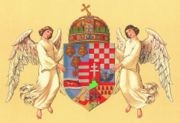
![匈牙利小姐評選揭曉[圖] 5月22日,在匈牙利首都
Click to view picture details](http://oson.ca/upload/images11/cache/99f9b3f79a958535f05f3c91a76c8b5e.jpg)
